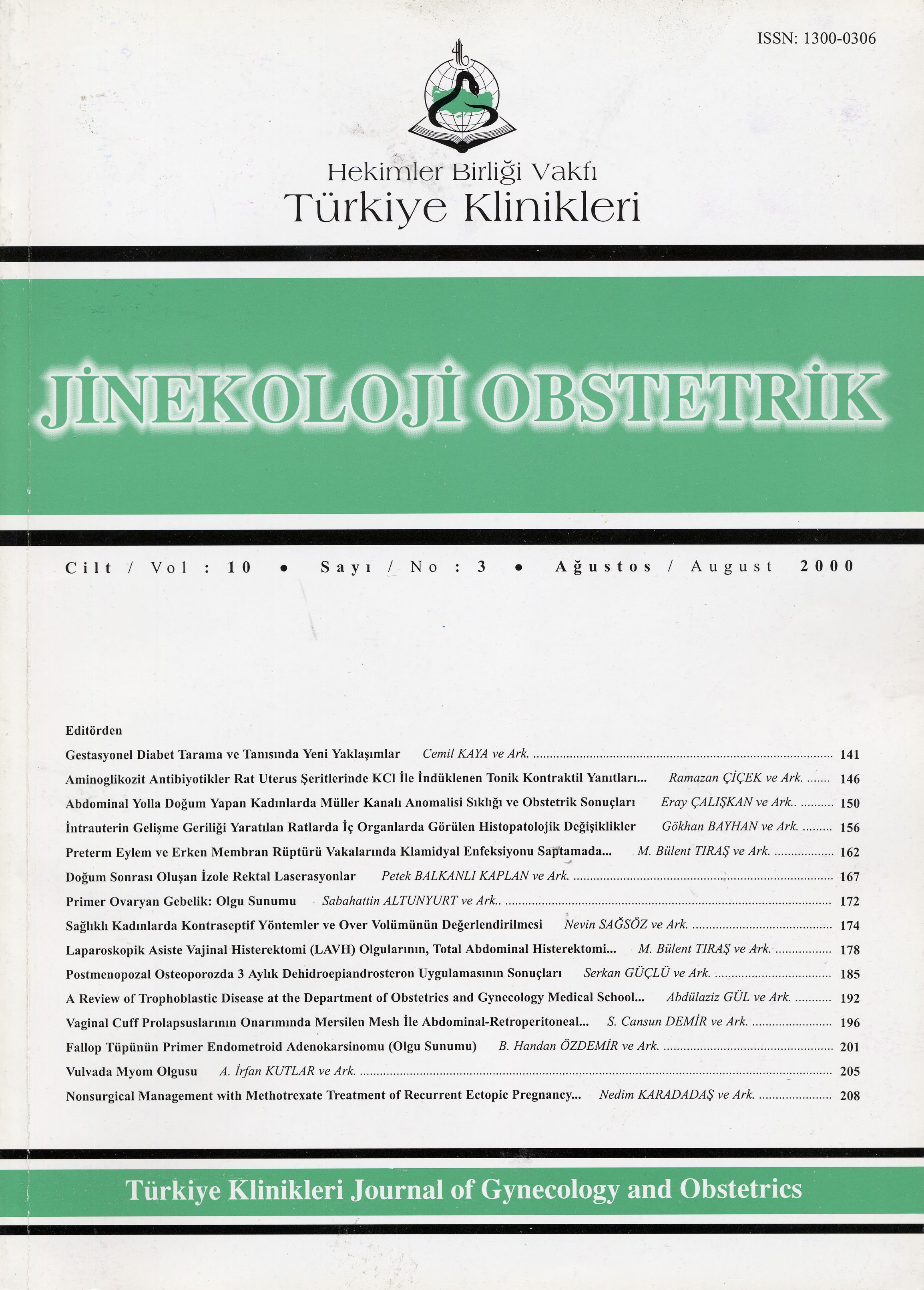Open Access
Peer Reviewed
ARTICLES
3271 Viewed1051 Downloaded
Contraceptive Methods And Ovarian Volume In Healthy Women
Sağlıklı Kadınlarda Kontraseptif Yöntemlerve Over Volümünün Değerlendirilmesi
Turkiye Klinikleri J Gynecol Obst. 2000;10(3):174-7
Article Language: TR
Copyright Ⓒ 2025 by Türkiye Klinikleri. This is an open access article under the CC BY-NC-ND license (http://creativecommons.org/licenses/by-nc-nd/4.0/)
ÖZET
Amaç: Rahim içi araç ve oral kontraseptif kullanımının bazal over volümü üzerine olan etkisini incelemek. Çalışmanın Yapıldığı Yer: Kırıkkale Üniversitesi Tıp Fakültesi Kadın Hastalıkları ve Doğum Anabilim Dalı, Kırıkkale. Materyal ve metod: Kırıkkale Üniversitesi Tıp Fakültesi Kadın Hastalıkları ve Doğum polikliniğine başvuran 71 sağlıklı vaka çalışma kapsamına alındı. Vakalar üç grup olarak incelendi. Birinci grupta oral kontraseptif kullanan 15 hasta, 2.grupta RİA takılmış olan 28 hasta ve 3.grupta bariyer yöntemi uygulayan 28 hasta değerlendirmeye alındı. Transvaginal yöntemle mestrual siklusun 1. ve 5. günlerinde over volümü ölçüldü. Bulgular: Bariyer yöntemi ile korunanlarda sağ over volümü 6,86 cm3 ± 2,91 cm3 sol over volümü 6,78 cm3 ± 2,87 cm3; RİA takılanlarda sağ over volümü 8,72 cm3 ± 2,18 cm3 sol over volümü 8,50 cm3 ± 2,39 cm3 ve oral kontraseptif kullananlarda sağ over volümü 4,28 cm3 ± 2,11 cm3 sol over volümü 4,24 cm3 ± 1,81 cm3 olarak ölçüldü. Her grupta sağ ve sol over volümleri arasında istatistiksel farklılık tesbit edilmezken (p>0,05); gruplar arasındaki over volümlerinde istatistiksel farklılık tesbit edildi. Sonuç: RİA kullananlarda doğal yöntemlerle korunanlara göre over volümde artış tesbit ederken oral kontraseptif kullananlarda azalma olduğunu gözlemledik.
Amaç: Rahim içi araç ve oral kontraseptif kullanımının bazal over volümü üzerine olan etkisini incelemek. Çalışmanın Yapıldığı Yer: Kırıkkale Üniversitesi Tıp Fakültesi Kadın Hastalıkları ve Doğum Anabilim Dalı, Kırıkkale. Materyal ve metod: Kırıkkale Üniversitesi Tıp Fakültesi Kadın Hastalıkları ve Doğum polikliniğine başvuran 71 sağlıklı vaka çalışma kapsamına alındı. Vakalar üç grup olarak incelendi. Birinci grupta oral kontraseptif kullanan 15 hasta, 2.grupta RİA takılmış olan 28 hasta ve 3.grupta bariyer yöntemi uygulayan 28 hasta değerlendirmeye alındı. Transvaginal yöntemle mestrual siklusun 1. ve 5. günlerinde over volümü ölçüldü. Bulgular: Bariyer yöntemi ile korunanlarda sağ over volümü 6,86 cm3 ± 2,91 cm3 sol over volümü 6,78 cm3 ± 2,87 cm3; RİA takılanlarda sağ over volümü 8,72 cm3 ± 2,18 cm3 sol over volümü 8,50 cm3 ± 2,39 cm3 ve oral kontraseptif kullananlarda sağ over volümü 4,28 cm3 ± 2,11 cm3 sol over volümü 4,24 cm3 ± 1,81 cm3 olarak ölçüldü. Her grupta sağ ve sol over volümleri arasında istatistiksel farklılık tesbit edilmezken (p>0,05); gruplar arasındaki over volümlerinde istatistiksel farklılık tesbit edildi. Sonuç: RİA kullananlarda doğal yöntemlerle korunanlara göre over volümde artış tesbit ederken oral kontraseptif kullananlarda azalma olduğunu gözlemledik.
ABSTRACT
Objective: Our aim was to investigate the effect of the use of the intrauterine contraceptive device and oral contraceptive on basal ovarian volume. Institution: Kırıkkale University Faculty of Medicine, Department of Obstetrics and Gynecology, Kırıkkale. Materials and Method: We included 71 healthy women who applied to Kırıkkale University Faculty of Medicine, Department of Obstetrics and Gynecology. We investigated the cases as 3 groups. In the first group there were 15 cases who were using oral contraceptive. In the second group there were 28 cases using barrier method. In the second group patients using barrier method were evaluated. The volume of the ovaries were measured on the 1. and 5. days of the menstrual cycle by transvaginal ultrasonography. Results: The right and left ovarian volume were 6,86 ± 2,93 cm3 and 6,78 ± 2,87 cm3 respectively in the cases who used barrier method. In the cases who used the intrauterine contraceptive device, the right and left ovarian volume were 8,72 ± 2,18 cm3 and 8,50 ± 2,39 cm3 respectively. The same measurements for oral contraceptive users were 4,28 ± 2,11 cm3 and 4,24±1,81 cm3 respectively. There were no statistically significant difference between the right and left ovarian volume in each group (p>0,05) but there were statistically significant difference in ovarian volumes between the groups. Conclusion: There was ovarian volume increase in intrauterine contraceptive device users whereas volume decreases in oral contraceptive users when we compared both group with the cases who use natural methods.
Objective: Our aim was to investigate the effect of the use of the intrauterine contraceptive device and oral contraceptive on basal ovarian volume. Institution: Kırıkkale University Faculty of Medicine, Department of Obstetrics and Gynecology, Kırıkkale. Materials and Method: We included 71 healthy women who applied to Kırıkkale University Faculty of Medicine, Department of Obstetrics and Gynecology. We investigated the cases as 3 groups. In the first group there were 15 cases who were using oral contraceptive. In the second group there were 28 cases using barrier method. In the second group patients using barrier method were evaluated. The volume of the ovaries were measured on the 1. and 5. days of the menstrual cycle by transvaginal ultrasonography. Results: The right and left ovarian volume were 6,86 ± 2,93 cm3 and 6,78 ± 2,87 cm3 respectively in the cases who used barrier method. In the cases who used the intrauterine contraceptive device, the right and left ovarian volume were 8,72 ± 2,18 cm3 and 8,50 ± 2,39 cm3 respectively. The same measurements for oral contraceptive users were 4,28 ± 2,11 cm3 and 4,24±1,81 cm3 respectively. There were no statistically significant difference between the right and left ovarian volume in each group (p>0,05) but there were statistically significant difference in ovarian volumes between the groups. Conclusion: There was ovarian volume increase in intrauterine contraceptive device users whereas volume decreases in oral contraceptive users when we compared both group with the cases who use natural methods.
MENU
POPULAR ARTICLES
MOST DOWNLOADED ARTICLES





This journal is licensed under a Creative Commons Attribution-NonCommercial-NoDerivatives 4.0 International License.










